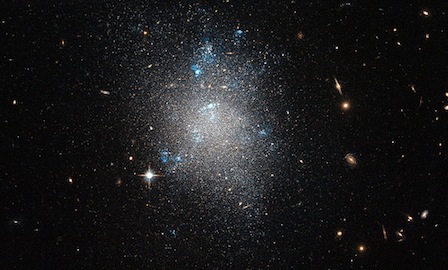Dying stars could host life, which we might be able to detect within the next decade. This finding, reported by e! Science, comes from a new theoretical study of Earth-like planets orbiting white dwarf stars.
Researchers found that we could detect oxygen in a white dwarf's planet more easily than for an Earth-like planet orbiting a Sun-like star.
"In the quest for extraterrestrial biological signatures, the first stars we study should be white dwarfs," said Avi Loeb, theorist at the Harvard-Smithsonian Center for Astrophysics (CfA) and director of the Institute for Theory and Computation.
When a star like our Sun dies, it sheds its outer layers, leaving behind a hot core called a white dwarf, which is typically about the size of Earth. The core will gradually cool over time, but it can retain enough heat to warm a nearby planet for billions of years.
A planet would have to be much closer in proximity to a white dwarf than Earth is to our Sun in order to be habitable with liquid water on its surface. Such a planet would need to circle the white dwarf once every 10 hours at a distance of roughly one million miles.
Before a star becomes a white dwarf it must swell into a red giant, destroying any nearby planets. To survive, a planet would have to arrive in the habitable zone after the star became a white dwarf. Habitable planets can form from leftover dust and gas or travel inward from a larger distance.
Loeb and his colleague Dan Maoz (Tel Aviv University) estimate that a survey of the 500 closest white dwarfs could yield one or more habitable planets. The best method for finding such planets is known as a transit search, which involves searching for a star that dims as an orbiting planet crosses in front of it. An Earth-sized planet would block a large fraction of a white dwarf's light, creating an obvious signal.
The atmospheres of transiting planets can absorb starlight from a white dwarf, showing whether that air contains water vapor or oxygen. Astronomers are looking for a planet with oxygen because the oxygen in Earth's atmosphere is continuously replenished by plant life. If all life were to come to an end on Earth, our atmosphere would displace all of its oxygen, which would oxidize the surface. This is why the presence of oxygen would increase the chances of finding life on a planet.
NASA's James Webb Space Telescope (JWST) is set to launch by the end of this decade and will attempt to identify the gases that exist on other planets.
"JWST offers the best hope of finding an inhabited planet in the near future," said Maoz.
Research conducted by Courtney Dressing and David Charbonneau of the CfA showed that the closest habitable planet is likely to orbit a red dwarf star, a cool, low-mass star experiencing nuclear fusion. However, the glare from a red dwarf would overpower the faint signal from an orbiting planet's atmosphere.
"Although the closest habitable planet might orbit a red dwarf star, the closest one we can easily prove to be life-bearing might orbit a white dwarf," said Loeb.
Image by NASA Goddard Photo and Video, courtesy of Creative Commons licensing.















